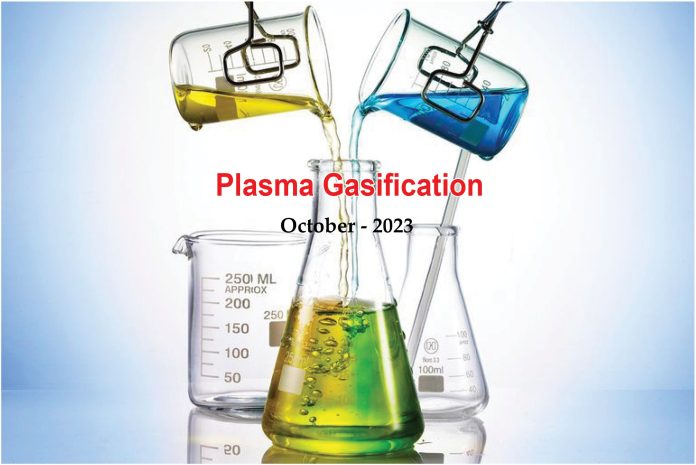Plasma gasification is an innovative waste-to-energy technology that uses extremely high temperatures to convert organic materials, such as municipal solid waste, into syngas and vitrified solids. This environmentally friendly process minimises landfill usage, reduces greenhouse gas emissions, and recovers valuable resources. Plasma gasification has the potential to revolutionise waste management and contribute to a more sustainable future.
Plasma Gasification
Plasma gasification is an advanced waste treatment technology that uses extremely high temperatures generated by a plasma arc to convert various types of waste materials into syngas. The heart of the plasma gasification system is the plasma arc, which is created by passing an electrical current through a gas, typically a combination of argon and hydrogen. This arc generates temperatures of up to 5500 degrees Celsius, hotter than the surface of the sun. Municipal solid waste (MSW), hazardous waste, or other feedstock materials are introduced into the plasma chamber. These materials can include organic waste, plastics, metals, and more. The extreme heat of the plasma arc breaks down the complex organic molecules in the waste into simpler components. As a result, the waste is converted into syngas, which is composed of hydrogen, carbon monoxide, and other gases.
The syngas may undergo a cleaning process to remove impurities, such as sulfur compounds and particulates, making it suitable for energy generation or other applications. The syngas can be used to produce electricity and heat through gas turbines, steam boilers, or other energy conversion systems. This makes plasma gasification a potential source of clean and sustainable energy. After gasification, there is typically a solid residue left, often referred to as slag or vitrified material. This material is inert and non-hazardous, making it suitable for use in construction or other applications.
Many Advantages
Plasma gasification offers several advantages compared to traditional methods of gasification, which use a less extreme heat source, such as direct or indirect gasification. Plasma gasification uses extremely high temperatures, exceeding 5500 degrees Celsius, which enables the breakdown of complex molecules in waste materials more efficiently. Plasma gasification can handle a broader range of feedstockS, including hazardous and difficult-to-process waste streams, due to its higher temperature capability. The syngas produced in plasma gasification is often of higher quality with lower impurities, making it more suitable for a variety of applications, including energy generation and chemical production. Plasma gasification is particularly effective at destroying hazardous materials and toxic substances in the waste feed, reducing the environmental impact. Traditional gasification processes may produce tars and other by-products that require further treatment. Plasma gasification tends to minimise the production of these by-products.
MSW Management
The growing volume of municipal solid waste (MSW) produced globally, approximately 440 kilograms per person annually, poses significant environmental and human risks due to the potential presence of hazardous pollutants. In many developing countries, MSW is either directed to sanitary landfills, reducing their lifespan, or disposed of in open dumping grounds, which elevates environmental and health risks. Therefore, it has become increasingly important to develop innovative technologies for the appropriate treatment of MSW to reduce its volume and mitigate negative impacts on ecosystems and society. Common methods for managing MSW include recycling, biological processes like composting and digestion, burial, and methods for recovering stored energy such as incineration, pyrolysis, and gasification. According to the principles of sustainable development, waste management should adhere to a hierarchy: waste prevention > reuse > recycling > recovery > burial. However, when it is impossible to implement the first three stages, energy recovery through incineration, pyrolysis, or gasification is considered the best practice.
Incineration and Pyrolysis
Incineration is a thermochemical process that involves the direct combustion of MSW in the presence of oxygen at high temperatures, usually above 850 degrees Celsius. Incineration significantly reduces waste volume and mass by approximately 90% and 75%, respectively. It also eliminates pathogens and generates heat, which can be converted into electrical energy. This method is widely used in developed countries and has gained popularity since the 1960s as a cost-effective process for waste-to-energy (WTE). However, incineration is associated with higher gas cleaning costs, and it can produce emissions of hazardous pollutants, such as SOx, NOx, dioxins, and furans, which can exceed permissible limits. In contrast, pyrolysis is a method with variable cost benefits and efficiency and is more suitable for homogeneous waste. Therefore, it is not generally applicable to the diverse composition of MSW. Gasification, however, offers an advantage by producing syngas under controlled conditions with partial oxidation of the raw material. This results in lower emissions of pollutants compared to other energy recovery processes.
Gasification
Gasification is particularly appealing for small cities where daily MSW production ranges from 20 to 100 tonnes. In countries like Brazil, where a large number of cities have a population of less than 200,000 and significant distances separate them, gasification becomes a practical option. However, a lack of financial investment and government support for commercialising the electricity generated during gasification has limited its industrial-scale implementation. While gasification has numerous advantages for waste treatment, it demands substantial energy input, which can affect its economic viability and lead to low or even negative net energy production. To address this, fluidised bed reactors have been used, which enhance mixing between reagents, maintain a uniform temperature, and allow for the use of different biomass types, including MSW or refuse-derived fuel from MSW.
Epilogue
Although plasma gasification is utilised for MSW processing on a real scale, technologies developed in the private sector are not widely shared. For instance, the Mutsu Waste Gasification facility in Japan processes 140 tonnes of MSW per day and has been generating electrical power since 2003. Similarly, Maharashtra Enviro Power Limited employs plasma gasification for the sterilisation of harmful residues. Plasma faces several challenges impeding widespread adoption. First, high initial capital costs for plasma facilities deter investment. Second, technical complexities and the need for skilled operators raise operational expenses. Environmental concerns, such as potential emissions of hazardous compounds and difficulties in managing solid residues, also hinder acceptance. Moreover, limited regulatory frameworks and public perception issues must be addressed to gain broader support. Lastly, competition from established waste management methods and limited proven long-term performance data make it difficult for plasma gasification to gain traction in the waste-to-energy sector.
































